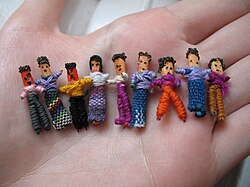
Worry dolls (also named trouble dolls; Spanish Muñecas quitapenas) are small, mostly hand-made dolls that originate from the highland indigenous people of Guatemala.
Description and material
| This section needs expansion. You can help by adding to it. (January 2018) |
Worry dolls are mostly hand-made. In Guatemala, they are made of wire, wool and colorful textile leftovers. The dolls are then dressed in traditional Mayan style. The size of the doll can vary between ½ inch and 2.0 inches. In western culture, the dolls are mostly made of pressed paper, adhesive tape, paper and colorful wool. In Guatemala, the dolls can be remarkably larger in size.
Function
In the dolls' original Guatemalan tradition, a local legend about the origin of the Muñeca quitapena refers to a Maya princess named Ixmucane. The princess received a special gift from the sun god which would allow her to solve any problem a human could worry about.
In traditional and modern times, worry dolls are given or lent to brooding, anxious, or sorrowful children. They would tell their doll about their sorrows, fears and worries, then hide the doll under their pillow before going to sleep at night. It is said that the child relinquishes their worries to the dolls during the night and by the next morning, all sorrows are said to have been taken away by the worry doll and they can move forward refreshed the next day.
Worry dolls have also played a role in modern pediatrics and child psychiatry. During a psychological interview with children, some counselors have offered a worry doll to the child as some kind of imaginary, but trustworthy "listener", "allayer" and "contact person". The doll, in turn, will work for psychiatrists, psychologists, educators and parents as some kind of "agent" and "troubleshooter" between child and adult.

Today, worry dolls are sold in huge quantity in Guatemala and Mexico. Nuns and poor children sell them to tourists as souvenirs. The dolls are quite popular since they are so small and thus easy to carry around.
References
- "No Worries! The Legend Of Guatemalan Worry Dolls". The Anthrotorian. Retrieved 2020-08-25.
- Charles E. Schaefer, Donna Cangelos: Essential Play Therapy Techniques: Time-Tested Approaches. Guilford Publications, New York 2016, ISBN 1462524516, page 102.
- ^ Nicole Joiner, Dagmar Rücker: Knüllen, falten, schneiden, färben: Kunterbunte Ideenkiste für Kinder von 3–8 Jahren. Ökotopia Verlag, Münster 2010, ISBN 3867021163, page 41.
- "The Legend of Guatemalan Worry Dolls". Exploring your mind. 2017-06-19. Retrieved 2020-08-25.
- Fred Christmann: Keine Angst vor Ängsten: Verhaltenstherapeutische Techniken lernen und anleiten. Schattauer Verlag, Stuttgart 2015, ISBN 3794531477, page 112.
- "The Magic of Worry Dolls: A Guide to Easing Your Worries". Worry Dolls. 2023-10-01. Retrieved 2024-09-05.
- Petra Stamer-Brandt, Monika Murphy-Witt: Das Erziehungs-ABC: von Angst bis Zorn (= GU Ratgeber Kinder-Serie). Gräfe Und Unzer, München 2011, ISBN 3833825510, page 34.
- Melanie Gräßer, Eike Hovermann: Kinder brauchen Rituale: So unterstützen Sie Ihr Kind in der Entwicklung. Stressfrei durch den Familien-Alltag. Empfohlen von: Akademie für Kindergarten, Kita und Hort. Humboldt, Hannover 2015, ISBN 3869107146, page 24-26.
- Jan-Henrik Johansson: Nuket ilman rajoja (dolls without limits). BoD - Books on Demand, 2014, ISBN 952286983X, page 170.